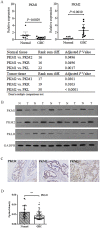Up-regulation of PKM2 promote malignancy and related to adverse prognostic risk factor in human gallbladder cancer
- PMID: 27283076
- PMCID: PMC4901292
- DOI: 10.1038/srep26351
Up-regulation of PKM2 promote malignancy and related to adverse prognostic risk factor in human gallbladder cancer
Abstract
Recently, pyruvate kinase M2 (PKM2) has been implicated in the progression of certain cancers and might play pivotal roles in the formation of malignancy. However, the role of PKM2 in gallbladder cancer had not been well investigated. This study analyzed associations between PKM2 expression status with various clinical and pathologic parameters in a large cohort of gallbladder cancer (GBC) patients from a long term follow up results. The expression level of pyruvate kinase isotypes in GBC tissues and their adjacent normal gallbladder tissues were estimated by qRT-PCR and Western blot. PKM2 mRNA level were significantly high in gallbladder cancer tissues than in adjacent noncancerous tissues (P < 0.001). High expression of the PKM2 was detected in 55.71% paraffin-embedded GBC tissue. The high PKM2 expression was independently associated with poorer overall survival in patients with GBC (median survival 11.9 vs 30.1 months; hazard ratio 2.79; 95% CI = 1.18 to 6.55; P = 0.02). These findings indicated elevated expression of PKM2 is a prognostic factor for poor GBC clinical outcomes, implied involving of PKM2 in GBC progression.
Figures





Similar articles
-
Both high expression of pyruvate kinase M2 and vascular endothelial growth factor-C predicts poorer prognosis in human breast cancer.Int J Clin Exp Pathol. 2015 Jul 1;8(7):8028-37. eCollection 2015. Int J Clin Exp Pathol. 2015. PMID: 26339369 Free PMC article.
-
MiR-139-5p is associated with poor prognosis and regulates glycolysis by repressing PKM2 in gallbladder carcinoma.Cell Prolif. 2018 Dec;51(6):e12510. doi: 10.1111/cpr.12510. Epub 2018 Aug 13. Cell Prolif. 2018. PMID: 30105813 Free PMC article.
-
The prognostic value of PKM2 and its correlation with tumour cell PD-L1 in lung adenocarcinoma.BMC Cancer. 2019 Mar 29;19(1):289. doi: 10.1186/s12885-019-5519-2. BMC Cancer. 2019. PMID: 30925904 Free PMC article.
-
Pyruvate kinase M2 (PKM2) in cancer and cancer therapeutics.Cancer Lett. 2021 Apr 10;503:240-248. doi: 10.1016/j.canlet.2020.11.018. Epub 2020 Nov 24. Cancer Lett. 2021. PMID: 33246091 Review.
-
Activators of PKM2 in cancer metabolism.Future Med Chem. 2014 Jun;6(10):1167-78. doi: 10.4155/fmc.14.70. Future Med Chem. 2014. PMID: 25078136 Review.
Cited by
-
Resveratrol's Anti-Cancer Effects through the Modulation of Tumor Glucose Metabolism.Cancers (Basel). 2021 Jan 7;13(2):188. doi: 10.3390/cancers13020188. Cancers (Basel). 2021. PMID: 33430318 Free PMC article. Review.
-
Impact of Immunometabolism on Cancer Metastasis: A Focus on T Cells and Macrophages.Cold Spring Harb Perspect Med. 2020 Sep 1;10(9):a037044. doi: 10.1101/cshperspect.a037044. Cold Spring Harb Perspect Med. 2020. PMID: 31615868 Free PMC article. Review.
-
Application and development of Deuterium Metabolic Imaging in tumor glucose metabolism: visualization of different metabolic pathways.Front Oncol. 2023 Nov 28;13:1285209. doi: 10.3389/fonc.2023.1285209. eCollection 2023. Front Oncol. 2023. PMID: 38090478 Free PMC article. Review.
-
Recent Advances on PKM2 Inhibitors and Activators in Cancer Applications.Curr Med Chem. 2024;31(20):2955-2973. doi: 10.2174/0929867331666230714144851. Curr Med Chem. 2024. PMID: 37455458 Review.
-
MicroRNA-122 regulates docetaxel resistance of prostate cancer cells by regulating PKM2.Exp Ther Med. 2020 Dec;20(6):247. doi: 10.3892/etm.2020.9377. Epub 2020 Oct 22. Exp Ther Med. 2020. PMID: 33178345 Free PMC article.
References
Publication types
MeSH terms
Substances
LinkOut - more resources
Full Text Sources
Other Literature Sources
Medical
Miscellaneous

